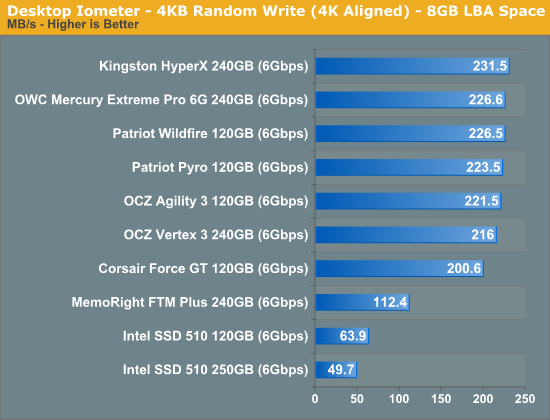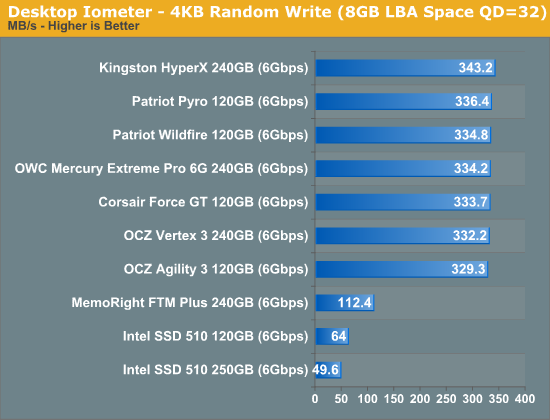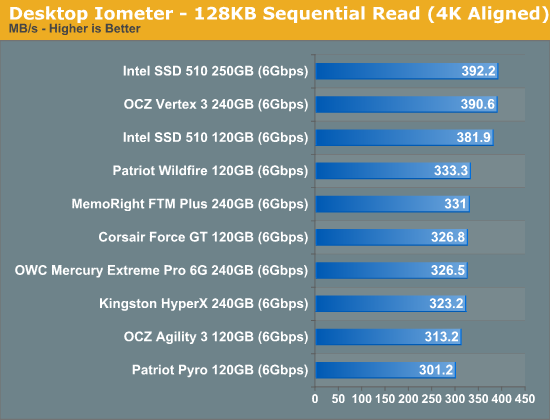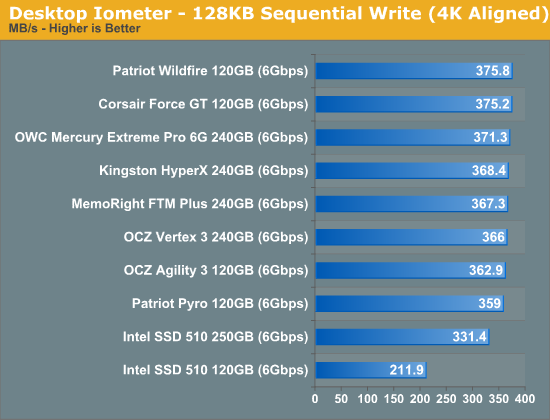The SandForce Roundup: Corsair, Kingston, Patriot, OCZ, OWC & MemoRight SSDs Compared
by Anand Lal Shimpi on August 11, 2011 12:01 AM ESTRandom Read/Write Speed
The four corners of SSD performance are as follows: random read, random write, sequential read and sequential write speed. Random accesses are generally small in size, while sequential accesses tend to be larger and thus we have the four Iometer tests we use in all of our reviews.
Our first test writes 4KB in a completely random pattern over an 8GB space of the drive to simulate the sort of random access that you'd see on an OS drive (even this is more stressful than a normal desktop user would see). I perform three concurrent IOs and run the test for 3 minutes. The results reported are in average MB/s over the entire time. We use both standard pseudo randomly generated data for each write as well as fully random data to show you both the maximum and minimum performance offered by SandForce based drives in these tests. The average performance of SF drives will likely be somewhere in between the two values for each drive you see in the graphs. For an understanding of why this matters, read our original SandForce article.

Random read performance is pretty consistent across all of the SF-2281 drives. The Patriot drives lose a bit of performance thanks to their choice in NAND (asynchronous IMFT in the case of the Pyro and Toggle NAND in the case of the Wildfire).

Most random writes are highly compressible and thus all of the SF-2281 drives do very well here. There's no real advantage to synchronous vs. asynchronous NAND here since most of the writes never make it to NAND in the first place. The Agility 3 and Vertex 3 here both use their original firmware while the newer drives are running the latest firmware updates from SandForce. The result is a slight gain in performance, but all things equal you won't see a difference in performance between these drives.
The MemoRight FTM Plus is the only exception here. Its firmware caps peak random write performance over an extended period of time. This is a trick you may remember from the SF-1200 days. It's almost entirely gone from the SF-2281 drives we've reviewed. The performance cap here will almost never surface in real world performance. Based on what we've seen, if you can sustain more than 50MB/s in random writes you're golden for desktop workloads. The advantage SandForce drives have is they tend to maintain these performance levels better than other controllers thanks to their real-time compression/dedupe logic.
Many of you have asked for random write performance at higher queue depths. What I have below is our 4KB random write test performed at a queue depth of 32 instead of 3. While the vast majority of desktop usage models experience queue depths of 0 - 5, higher depths are possible in heavy I/O (and multi-user) workloads:

All of the SF-2281 drives do better with a heavier load. The MemoRight drive is still capped at around 112MB/s here.
Sequential Read/Write Speed
To measure sequential performance I ran a 1 minute long 128KB sequential test over the entire span of the drive at a queue depth of 1. The results reported are in average MB/s over the entire test length.

The older SF-2281 firmwares did a bit better in some tests than the newer versions, hence the Vertex 3 being at the top here. All of the newer drives perform pretty similarly in our sequential read test.

The same goes for our sequential write test - all of the SF-2281 drives perform very similarly.










90 Comments
View All Comments
rigged - Sunday, August 14, 2011 - link
are you using the SF-2281 or SF-2282 based OWC drive?only the new 240GB and 480GB drives from OWC use this controller.
http://eshop.macsales.com/item/Other+World+Computi...
Under Specs
Controller: SandForce 2282 Series
Justin Case - Sunday, August 14, 2011 - link
It's not just the BSOD. Even systems that don't crash have frequent freezes for anything up to 90 seconds. Tht's enough to make network transfers abort, connections to game servers drop, etc..I've tried three Corsair drives on multiple platforms and I know people who have used those and also OCZ. Not a single drive was 100% stable on any platform. They tended to crash more on Intel chipsets and freeze more on AMD chipsets (sometimes recoverable, sometimes a hard lock), but NOT A SINGLE ONE was problem-free for more than 2 or 3 days in a row (often you'll get two or three freezes within the sme hour).
The first job of a drive is to reliably hold your data. People use SSDs to install their OS and applications. It takes days to reinstall and recover from errrors. It's irrelevant if some drive gives you 500 happybytes in some benchmark when the same drive keeps losing your thesis or getting you killed in Tem Fortress. I have systems with Raptors that have been running for 5 years without a single error.
If you have any problems (which you will), don't let them string you along with nonsense about your cables or obscure BIOS options or promises about future fixes. Return the drive and demand a refund. Both OCZ and Corsair are still selling drives that they KNOW to be defective, and removing any reference to those problems from the support section of their sites (you'll still find thousands of complaints in their user forums, though). Demanding refunds (or starting a class action suit) seems to be the only language they understand.
SjarbaDarba - Sunday, August 14, 2011 - link
I experience some hard locks too, mainly during gaming only since upgrading to a 120GB Vertex 3.System is an X58-UD7 + i7-960, 2 GTX570 OC Sli, Seasonic X-850 80+ GOLD, 6GB Corsair DDR3 1600C8.
Was originally using 2 x 300GB Velociraptors in RAID 0 with WD1002FAEX and Seagate 2TB XT, stable for 1-2 months before upgrading to the V3. Storage configuration since upgrade is 120GB Vertex3, WD1002FAEX and Raptors RAID 0.
System perfectly stable under 600GB RAID 0 OS with Crysis 2, CS:S, LoL, L4D, L4D2 and Borderlands all playing stable at all loads with hardware monitoring active, no problems found with any hardware or software at this point, system performed flawlessly for all tasks.
Dropped the V3 in with the typical "It's fast - but it could be faster" attitude we all know and love and instantly started experiencing ... whackness. System works flawlessly 99% of the time, however, a few times a week I will lock up and need to power cycle - I have the SSD running in AHCI with TRIM etc. enabled, page file, defrag etc. turned off and pretty much every detail of the drive perfectly specced for optimum performance.
If I lock up and have to cycle, upon restart the SATA controller the SSD is attached to will hang at BIOS and not detect the V3 - however - cycling again at this point allows the SSD to be detected within ~1 second and Windows boots normally.
At this point, however (and using nVidia 275.33 drivers) returning to desktop boots me in 800x600 resolution with no nVidia control panel and a further power cycle is required again to reset the resolution.
Yet to test this problem with nVidia 280.16 drivers but havn't had stability problems since then.
Sorry for any tl;dr, just thought Annad might like to hear about a strange error I've encountered in the SF controller.
P.S: System is 3DMark, Furmark and Prime stable, it just has some whack locks randomly and the SSD disappears completely for a power cycle.
readyrover - Monday, August 15, 2011 - link
I was going to dive into my first SSD with a Bulldozer build on the upcoming horizon...until this all shakes out...absolutely no way. My usage is for processing large music files on a Digital Audio Workstation with multiple time based effects and multi-tracks of instruments. I have been experiencing some latency bottle necks and thought "wow" ssd is an instant fix!If they have ironed out the problems and the reviews' negative percentages drop back below an astounding 20% of my recent research..then perhaps a year from now...Bulldozers should be less expensive then as well..
Just my humble opinion, but I can't roll the dice on a hit and miss crash...."Please Mr. $120 hour guitarist...would you wait an hour for me to fix the computer and replay that absolutely inspired, one of kind improvisation...AGAIN!
Brrrr...shiver...run away fast!
Gothmoth - Friday, August 19, 2011 - link
i have a few asus z68- v pro boards (three to be exact).all of them have an vertex3 120 GB SSD as C drive.
all have 16 GB g.skill ram and run win 7 64 bit sp1.
i had not a single issue with the vertex 3 since i bought them (13. april 2011).
i have still the first firmware running.
thank god i have avoided updating to firmware v2.06 or v2.09.
i have put the vertex3 240 GB from a friend in my system with firmware 2.06.
we could reproduce the BSOD after 1 hour.
he has constand crashes on his gigabye motherboard based system.
we but one of my vertex3 120GB SSD in his system and it was running flawless for 2 days.
twindragon6 - Friday, August 26, 2011 - link
I know the market sucks! But I would rather pay more for something that actually works than pay less for something that doesn't and be stuck with an expensive paperweight!alpha754293 - Friday, September 2, 2011 - link
Anand:Does that BSOD bug only affect drives that are boot drives? i.e. What would happen if the test drives were slave/data/non-OS-containing drives? Does it still do the same BSOD thing?
Keith2468 - Monday, December 12, 2011 - link
Digital people tend to think digital issue when looking for the causes of computer hardsware and software failure. But sometimes the failures are not digital in origin.The power supply may well be critical to SSD failures.
What causes SSD failures? Largely power disturbances to the SSD.
Why are SSDs with smaller IOPS and smaller caches less likely to fail?
Less data to move from volatile RAM cache to Flash when power disturbances occur.
Why should you not use a notebook SSD in a desktop?
A notebook SSD designer will typically assume that the notebook's battery means he doesn't have to design for power distrubances.
"The design of an SSD's power down management system is a fundamental characteristic of the SSD which can determine its suitability and compatibility with user operational environments. Systems integrators must take this into account when qualifying SSDs in new applications - because subtle differences in OS timings, rack power loading and rack logic affect some types of SSDs more than others. Users should be aware that power management inside the SSD (a factor which doesn't get much space in most product datasheets) is as important to reliable operation as management of endurance, IOPS, cost and other headline parameters."
http://www.storagesearch.com/ssd-power-going-down....
jfraser7 - Friday, November 14, 2014 - link
This article is very useful because Mac OS X 10.10 Yosemite dropped all support for third-party Solid State Drives, except for those which use SandForce controllers.jfraser7 - Friday, November 14, 2014 - link
Also, all three of Kingston's recent Solid State Drive lines(V300, KC300 & HyperX) use SandForce controllers.